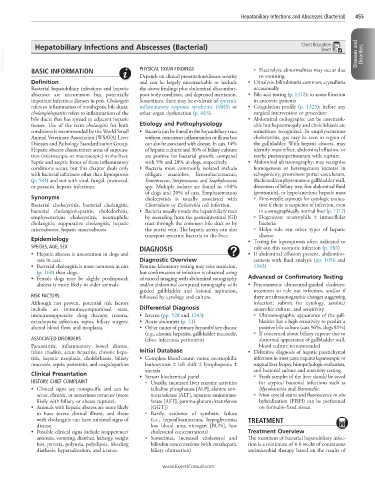Page 930 - Cote clinical veterinary advisor dogs and cats 4th
P. 930
Hepatobiliary Infections and Abscesses (Bacterial) 455
Hepatobiliary Infections and Abscesses (Bacterial) Client Education
Sheet
VetBooks.ir Diseases and Disorders
PHYSICAL EXAM FINDINGS
BASIC INFORMATION
to vomiting.
Depends on clinical presentation/disease severity ○ Electrolyte abnormalities may occur due
Definition and can be largely unremarkable or include • Urinalysis: bilirubinuria common, crystalluria
Bacterial hepatobiliary infections and hepatic the above findings plus abdominal discomfort, occasionally
abscesses are uncommon but potentially poor body condition, and depressed mentation. • Bile acid testing (p. 1312): to assess function
important infectious diseases in pets. Cholangitis Sometimes, there may be evidence of systemic in anicteric patients
refers to inflammation of intrahepatic bile ducts; inflammatory response syndrome (SIRS) or • Coagulation profile (p. 1325): before any
cholangiohepatitis refers to inflammation of the other organ dysfunction (p. 665). surgical intervention or procedure
bile ducts that has spread to adjacent hepatic • Abdominal radiographs: can be unremark-
tissues. Use of the term cholangitis for both Etiology and Pathophysiology able but hepatomegaly and cholelithiasis are
conditions is recommended by the World Small • Bacteria can be found in the hepatobiliary tract sometimes recognized. In emphysematous
Animal Veterinary Association (WSAVA) Liver without concurrent inflammation or illness but cholecystitis, gas may be seen in region of
Diseases and Pathology Standardization Group. can also be associated with disease. In cats, 14% the gallbladder. With hepatic abscess, may
Hepatic abscess characterizes areas of suppura- of hepatic cultures and 36% of biliary cultures identify mass effect, abdominal effusion, or
tion (microscopic or macroscopic) in the liver. are positive for bacterial growth, compared rarely, pneumoperitoneum with rupture.
Septic and aseptic forms of these inflammatory with 5% and 28% in dogs, respectively. • Abdominal ultrasonography: may recognize
conditions occur, but this chapter deals only • Bacteria most commonly isolated include homogenous or heterogenous increase in
with bacterial infections other than leptospirosis obligate anaerobes, Enterobacteriaceae, echogenicity, prominent portal vasculuture,
(p. 583) and not with viral, fungal, protozoal, Enterococcus, Streptococcus, and Staphylococcus thickened/emphysematous gallbladder wall,
or parasitic hepatic infections. spp. Multiple isolates are found in ≈50% distention of biliary tree, free abdominal fluid
of dogs and 20% of cats. Emphasematous (peritonitis), or hypo/anechoic hepatic mass
Synonyms cholecystisis is usually associated with ○ Fine-needle aspirates for cytologic evalua-
Bacterial cholecystitis, bacterial cholangitis, Clostridium or Escherichia coli infection. tion if there is suspicion of infection, even
bacterial cholangiohepatitis, choledochitis, • Bacteria usually invade the hepatobiliary tract in a sonographically normal liver (p. 1112)
emphysematous cholecystitis, neutrophilic by ascending from the gastrointestinal (GI) ○ Degenerate neutrophils ± intracellular
cholangitis, suppurative cholangitis, hepatic tract through the common bile duct or by bacteria
microabscess, hepatic macroabscess the portal vein. The hepatic artery can also ○ Helps rule out other types of hepatic
transport systemic bacteria to the liver. disease
Epidemiology • Testing for leptospirosis often indicated to
SPECIES, AGE, SEX DIAGNOSIS rule out this zoonotic infection (p. 583)
• Hepatic abscess is uncommon in dogs and • If abdominal effusion present, abdomino-
rare in cats. Diagnostic Overview centesis with fluid analysis (pp. 1056 and
• Bacterial cholangitis is more common in cats Routine laboratory testing may raise suspicion, 1343)
(p. 160) than dogs. but confirmation of infection is obtained using
• Female dogs may be slighly predisposed; advanced imaging with abdominal sonography Advanced or Confirmatory Testing
abscess is more likely in older animals. and/or abdominal computed tomography with • Percutaneous ultrasound-guided cholecys-
guided gallbladder and lesional aspiration, tocentesis to rule out infection, and/or if
RISK FACTORS followed by cytology and culture. there are ultrasonographic changes suggesting
Although not proven, potential risk factors infection; submit for cytology, aerobic/
include an immunocompromised state, Differential Diagnosis anaerobic culture, and sensitivity.
immunosuppressive drug therapy, trauma, • Icterus (pp. 528 and 1243) ○ Ultrasonographic appearance of the gall-
extrahepatic infection, sepsis, biliary surgery, • Acute abdomen (p. 21) bladder has a high sensitivity to predict a
altered blood flow, and neoplasia. • Other causes of primary hepatobiliary disease positive bile culture (cats 96%, dogs 81%)
(e.g., chronic hepatitis, gallbladder mucocele, ○ If concerned about biliary rupture due to
ASSOCIATED DISORDERS feline infectious peritonitis) abnormal appearance of gallbladder wall,
Pancreatitis, inflammatory bowel disease, blood culture recommended
feline triaditis, acute hepatitis, chronic hepa- Initial Database • Definitive diagnosis of hepatic parenchymal
titis, hepatic neoplasia, cholelithiasis, biliary • Complete blood count: varies; neutrophilic infections in most cases requires laparoscopic or
mucocele, sepsis, peritonitis, and coagulopathies leukocytosis ± left shift ± lymphopenia ± surgical liver biopsy, histopathologic evaluation,
anemia and bacterial culture and senstivity testing.
Clinical Presentation • Serum biochemical panel ○ Fresh samples of the liver should be saved
HISTORY, CHIEF COMPLAINT ○ Usually, increased liver enzyme activities for atypical bacterial infections such as
• Clinical signs are nonspecific and can be (alkaline phosphatase [ALP], alanine ami- Mycobacteria and Bartonella.
acute, chronic, or sometimes peracute (more notransferase [ALT], aspartate aminotrans- ○ Most special stains and fluorescence in situ
likely with biliary or abcess rupture). ferase [AST], gamma-glutamyltransferase hybridization (FISH) can be performed
• Animals with hepatic abscess are more likely [GGT]) on formalin-fixed tissue.
to have severe clinical illness, and those ○ Rarely, evidence of synthetic failure
with cholangitis can have minimal signs of (i.e., hypoalbuminemia, hypoglycemia, TREATMENT
disease. low blood urea nitrogen [BUN], low
• Possible clinical signs include inappetence/ cholesterol concentrations) Treatment Overview
anorexia, vomiting, diarrhea, lethargy, weight ○ Sometimes, increased cholesterol and The treatment of bacterial hepatobiliary infec-
loss, pyrexia, polyuria, polydipsia, bleeding bilirubin concentrations (with extrahepatic tion is a minimum of 4-6 weeks of continuous
diathesis, hypersalivation, and icterus. biliary obstruction) antimicrobial therapy based on the results of
www.ExpertConsult.com

